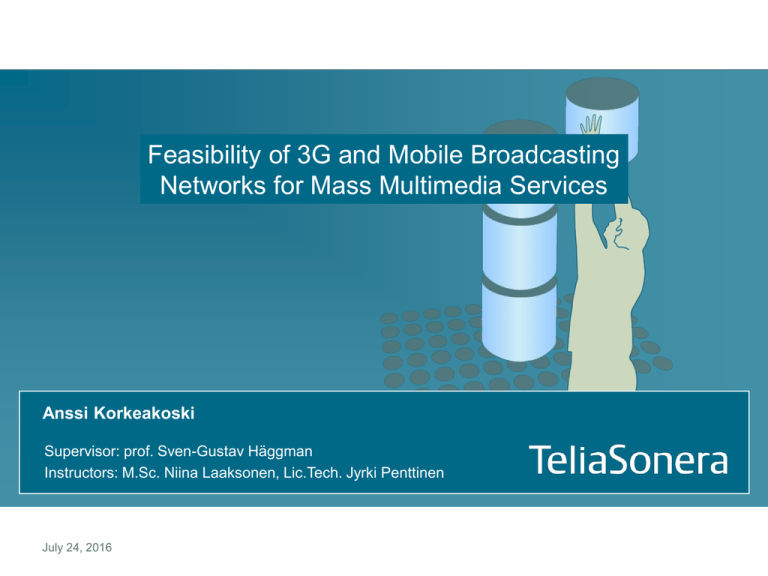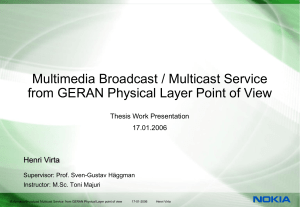Feasibility of 3G and Mobile Broadcasting Networks for Mass Multimedia Services
advertisement

Feasibility of 3G and Mobile Broadcasting Networks for Mass Multimedia Services Anssi Korkeakoski Supervisor: prof. Sven-Gustav Häggman Instructors: M.Sc. Niina Laaksonen, Lic.Tech. Jyrki Penttinen July 24, 2016 Contents • Background • Objectives & Methodology • Multimedia Broadcast/Multicast Service • Digital Video Broadcasting – Handheld • Evaluation & Conclusions July 24, 2016 2 Background • As the number of simultaneous users increases within the service area, efficient delivery of content becomes more and more crucial • Therefore, broadcasting should be favoured to transmit mass services for large audiences in order to decrease the delivery costs per user • Different mobile broadcast systems have been designed but this thesis focuses on two solutions with different backgrounds: MBMS (Multimedia Broadcast/Multicast Service) and DVB-H (Digital Video Broadcast – Handheld) Unicast July 24, 2016 Broadcast 3 Objectives & Methodology • Objectives: – Introduce MBMS and DVB-H – Study and compare the main technical constraints of the radio interface of these systems – Evaluate the effect of these constraints on the feasible service portfolio as well as user environment – Sketch example user scenarios • Methodology: – Literary study based on 3GPP and ETSI specifications, conference papers and research articles – Author’s own experience from DVB-H networks also utilized July 24, 2016 4 MBMS (Multimedia Broadcast/Multicast Service) • Specification work of MBMS (Rel 6) in 3GPP is partly unfinished at the moment • MBMS is designed for both GSM/EDGE and UMTS Terrestrial Radio Access Networks (GERAN/UTRAN) – This thesis focuses on UTRAN • Two modes: Broadcast mode and multicast mode • In multicast mode, either DCH or FACH channel used depending on the number of MBMS users within the cell • MBMS provides bidirectional p-t-p correction of erroneous data after the broadcast session – Only for services with no strict delay requirements, such as file downloading July 24, 2016 5 MBMS architecture Other networks e.g. Internet Content Provider CBC OSA SCS Uu UTRAN Iu Gn/Gp SGSN Um GERAN Iu/Gb Gmb GGSN Gr BM-SC Content Provider Gi HLR • Broadcast Multicast Service Centre (BM-SC) is a new network element • Enhancements to SGSN, GGSN, UTRAN and UE – More or less a vendor-specific issue July 24, 2016 6 Digital Video Broadcasting - Handheld • Specification work of DVB-H is finished in ETSI • DVB-H is based on DVB-T(errestrial), but supports handheld portable and mobile reception • The main additional features of DVB-H: – Time slicing technique to achieve better battery saving percentage – MPE-FEC error correction mechanism for additional robustness and mobility – 4K-mode for mobility and radio network design flexibility • Usually the content delivered in DVB-H network is associated only to mobile TV, but basically also other services, such as file downloading, is viable July 24, 2016 7 IP Datacasting IPDC Network Operator IPDC Service Operator IPDC Service Platform IP transmission Mobile Network Operator Interaction in Uplink GSM/GPRS/ E-GPRS/UMTS Network Content Provider IPDC Content and Services Mobile Service Provider GSM/GPRS/ E-GPRS/ UMTS Service Platform IPDC = IP Datacasting July 24, 2016 8 Feasible data rates in MBMS and DVB-H • Base station output power consumption limits the bit rates per service in MBMS – According to simulations, e.g. in pedestrian environment, at least 15 % fractional BS power (Ec/Ior) required for a 64 kbit/s bearer (1% BLER target, –3 dB geometry) – Lower MBMS performance can be expected in macrocellular WCDMA networks due to lower geometry factor values at the cell edge • In DVB-H, the overall maximum throughput per carrier is max. ~15 Mbit/s in mobile environment, which is further allocated to different services – In practice, the battery saving target limits the maximum feasible bit rate per service July 24, 2016 9 Error correction mechanisms • The implementation of FEC (Forward Error Correction) in MBMS is not yet standardized in 3GPP • DVB-H utilizes FEC in two layers – Code rates: 1/2, 2/3, 3/4, 5/6 and 7/8 • Optional back-up error correction mechanism is implemented in MBMS via unicast links for file delivery services – In theory, this solution is scalable only if the repair requests are spread in time and across multiple servers – Similar mechanism has not been decided – at least yet – to implement in DVB-H July 24, 2016 10 User environment • E.g. in Finland, UTRAN has been built so far only to largest cities – MBMS could also utilize the vast coverage of GERAN • In the end, the quality and coverage area of the networks for MBMS and DVB-H services depends on the network operator itself – Economic realities guide the decisions more than technical aspects • Both MBMS and DVB-H support mobility well, but handovers must be performed more often on average in UMTS network – The max. distance between two main transmitters within a SFN (Single Frequency Network) cell can be even 67 km depending on the network parameters July 24, 2016 11 Other aspects • MBMS can utilize the existing GERAN/UTRAN networks (+frequencies) • Most likely a dedicated DVB-H network must be built – It is possible to use the existing DVB-T networks for DVB-H services, but problems might be encountered in indoor coverage, mobility, capacity etc. – New DVB-H infrastructure and frequency licences increase expenditures! • Status of the specification work and technology maturity July 24, 2016 12 Conclusions and future work • DVB-H has better capabilities to provide more versatile service portfolio – The employment of a dedicated MBMS carrier should be considered based on traffic statistics and service needs • Due to utilization of mobile cellular network, local and interactive services with shorter response time are more suitable for MBMS • MBMS should not be rolled out until the UMTS customer penetration is dense enough • Future work: – Studies of other mobile broadcasting systems – UMTS radio network measurements (e.g. cumulative distribution function of the geometry factor in real network) in order to better evaluate the MBMS capacity July 24, 2016 13 The Nordic and Baltic telecommunications leader July 24, 2016



![JOINING procedure (TJ) (315) (330) K [MccH] SERVICE](http://s2.studylib.net/store/data/018313512_1-915737b58b7b166344d1dddbce6fda9f-300x300.png)